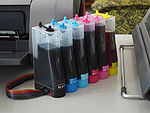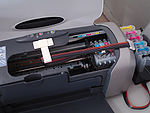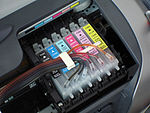This is an old revision of this page, as edited by 89.179.12.208 (talk) at 08:39, 8 October 2008. The present address (URL) is a permanent link to this revision, which may differ significantly from the current revision.
Revision as of 08:39, 8 October 2008 by 89.179.12.208 (talk)(diff) ← Previous revision | Latest revision (diff) | Newer revision → (diff)| This article does not cite any sources. Please help improve this article by adding citations to reliable sources. Unsourced material may be challenged and removed. Find sources: "Continuous ink system" – news · newspapers · books · scholar · JSTOR (February 2008) (Learn how and when to remove this message) |
| Template:Wikify is deprecated. Please use a more specific cleanup template as listed in the documentation. |
| The neutrality of this article is disputed. Relevant discussion may be found on the talk page. Please do not remove this message until conditions to do so are met. (February 2008) (Learn how and when to remove this message) |



A Continuous Ink System (CIS) also known as Continuous Flow System (CFS), Digital Image Prints System (DIPS) and bulk feed ink system, is a cost-effective replacement for ink-jet printer cartridges. In contrast to conventional cartridges, a CIS/CFS uses very large (about 100ml/color) ink tanks, which are connected with tubes to the printhead nozzles. The tanks can be refilled from an ink bottle - there is no need for a syringe.
The first known desktop printer bulk feed system was developed in 1998 for the Epson 640 printer.On Russia ciss Epson that EpsonS Continuous Ink System
The first "Spongeless CIS" was designed by InkRepublic in 2002 using an spongeless damper with tubing. InkRepublic was also the first pigment-based CIS provider. Since, many more CFS systems were developed to cover most Epson and Canon printers. These bulk feed systems also allow users to use inexpensive aftermarket inkjet inks as well as specialty inks like HT Heat Transfer inks for T-Shirt transfers or Black and White inks for gallery quality B&W printing. These options have allowed users to produce specialty prints at a fraction of the cost of purchasing special cartridges or using more expensive printing solutions.
The inkjet printer industry has viewed continuous flow systems as a threat to profits from sale of ink cartridges, while high volume users demand lower cost ink. The result has been an arms race - the manufacturers have changed ink formulae, smart chips, printer & cartridge models so frequently that the CIS suppliers have had difficulty keeping up. Recently CIS manufacturing has shifted from a "one of a kind - customization" cottage industry to higher volume mass market production as Chinese engineers realized its market potential. The result has been a significant reduction in pricing of a CIS. System prices have dropped from the $500 range to less than $100.
To avoid the need to remove the cartridge and reset the smart chip every time the chip thinks the cartridge has run out of ink, CIS often reverse engineer the smart chip and build a custom version that automatically resets itself. Software drivers for the printer may balk at these third party chips and workarounds are sometimes required.
One major benefit of a CIS is the ability to use special inks. For instance, it is often possible to purchase ink systems with inks types other than those originally supplied with the printer—such as dye inks in a pigment-ink printer and vice versa and graduated black inks in color printers..
References
A continuous ink supply system feeds ink cartridges by way of silicone tubing.
This computer hardware article is a stub. You can help Misplaced Pages by expanding it. |